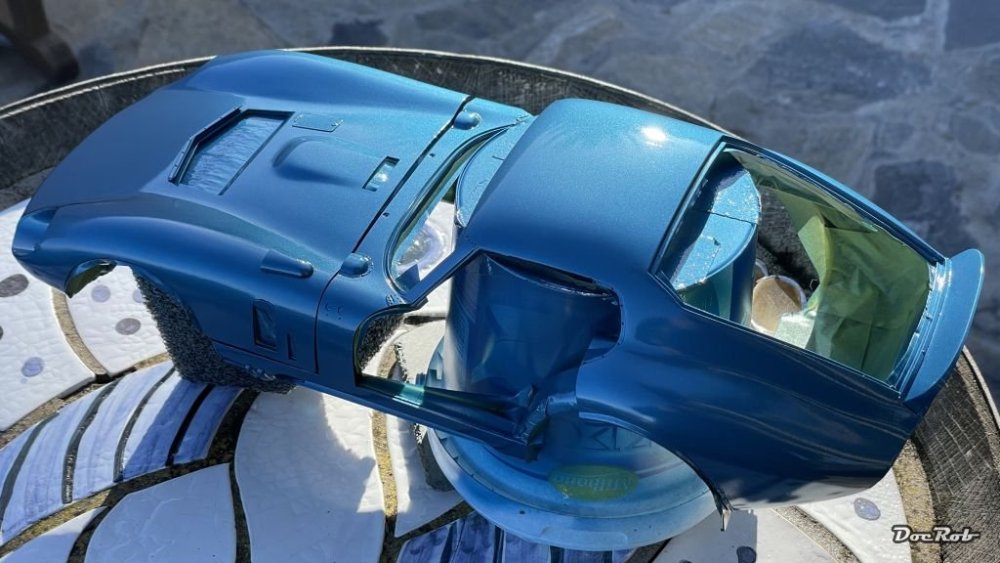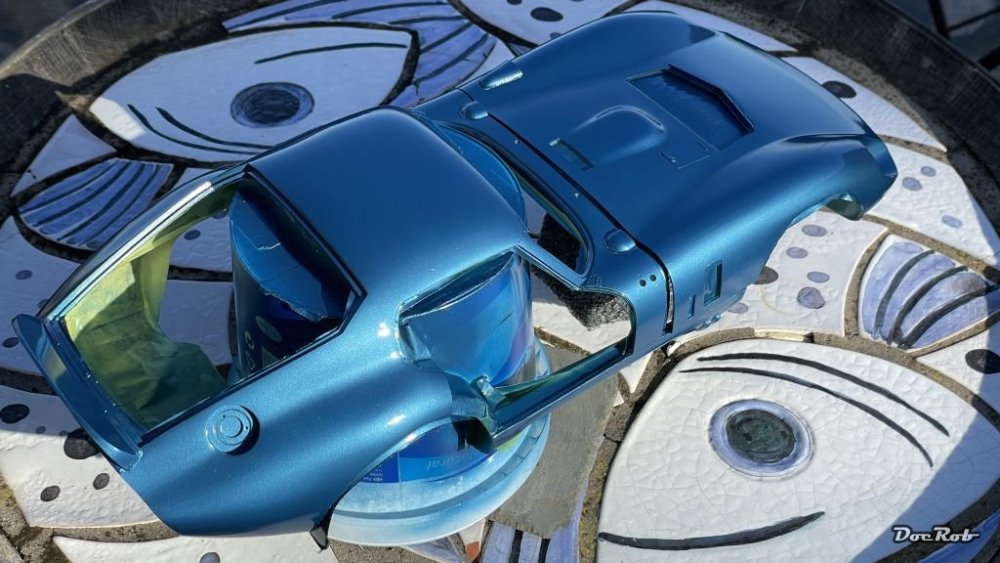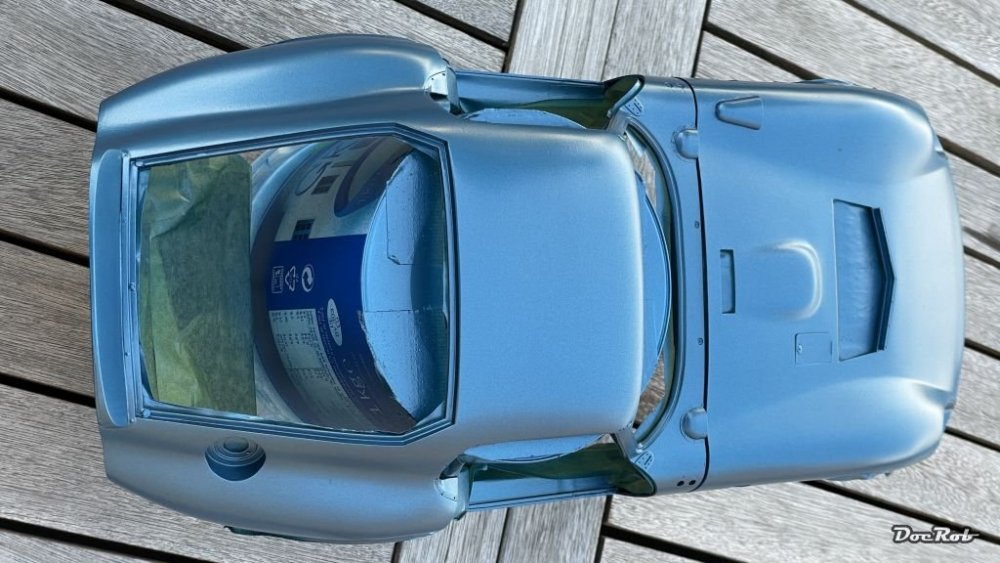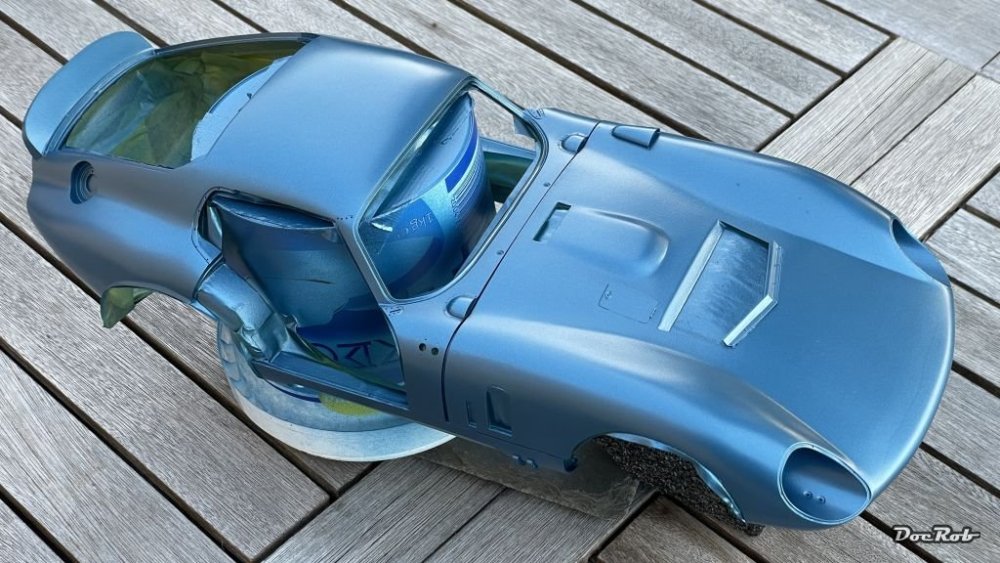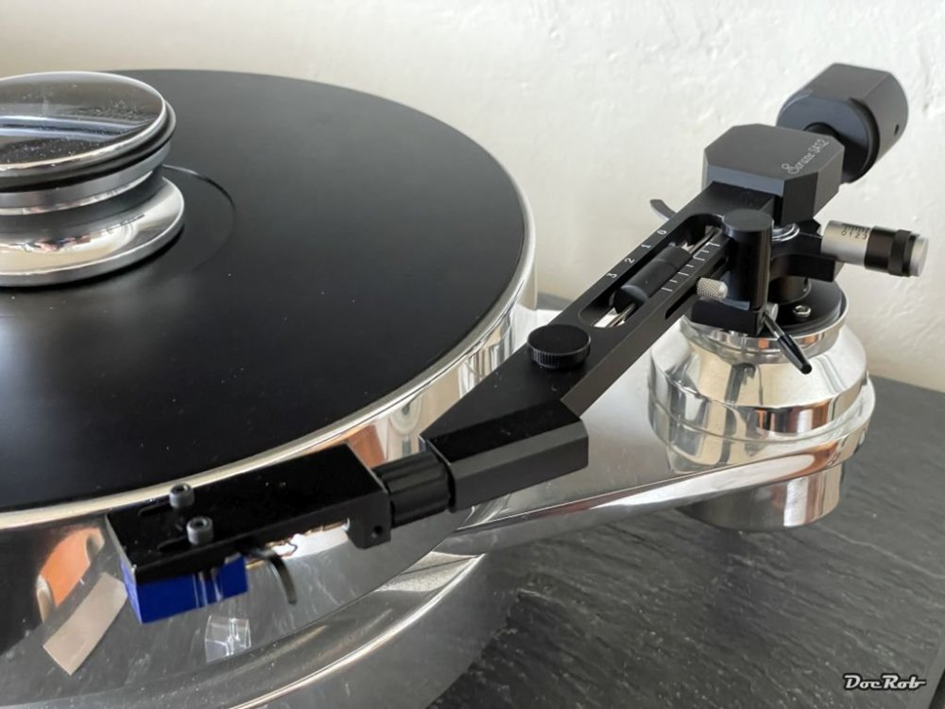-
Posts
6,827 -
Joined
-
Last visited
Content Type
Profiles
Forums
Events
Gallery
Everything posted by DocRob
-
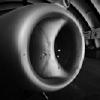
Cobra Coupe - Le Mans - Model Factory Hiro 1/12
DocRob replied to DocRob's topic in LSM 1/35 and Larger Work In Progress
Thank you Paul. I used Zero Paints lacquer clear gloss with about 40% leveling thinner added. Came out pretty decent and should be good enough for decaling. The very high gloss is difficult to capture on the photos. Before, I applied a fourth coat of Cobra Blue overall, to let the tiny blemishes on the bonnet disappear. Unfortunately, during photographing, I tried to hinder my cat, jumping onto the model, it hit a stone and I have another small mark in my paintjob . Cheers Rob -
Didn´t happen, luckily . Cheers Rob
-

Cobra Coupe - Le Mans - Model Factory Hiro 1/12
DocRob replied to DocRob's topic in LSM 1/35 and Larger Work In Progress
Definitely a job for the 0,4 mm needle and nozzle, as there is a lot of body to spray. I feared, the doors or bonnet would look slightly different, not sprayed mounted together. Luckily that seemed unfound, as I can see no differences in color rendition. Cheers Rob -

Eduard Spitfire Mk. XVI Bubbletop 1/48
DocRob replied to CANicoll's topic in LSM 1/48 Work in Progress
Have fun with the Super Bowl tonight (at least, it´s night, where I live), Chris, I will view as well. I thoroughly clean my airbrush sometimes, specially before spraying car bodies or clear coats. Today, I sprayed a fourth layer of Cobra blue and when I cleaned the airbrush, a glass shaker ball from the Cobra Blue jar was falling out of the airbrush. Don´t know, how it sprayed so well with it . Cheers Rob -

Cobra Coupe - Le Mans - Model Factory Hiro 1/12
DocRob replied to DocRob's topic in LSM 1/35 and Larger Work In Progress
Thank you Kevin, Number Five colors dry semi matte and today, I gave the Cobra a fourth coat, to hide the tiny blemishes on the bonnet. I will not polish now before clear coating. Then it´s decals and more clear gloss coating with polishing in the end. Cheers Rob -
Following closely, Gus, I have two Eduard Mig 21 in my stash and feel the itch to build one soon. Nice job on the interior psychedelic torquoise. Same reason for limited benchtime today, Phil, but different cause. Today is Supebowl Sunday . Cheers Rob
-
Very neat. If you ever need some body color for the Cobra Coupe... . Yours is definitely the simpler kit by far . Cheers Rob
-
Cute Carl, an Egg-Beat . Cheers Rob
-

Cobra Coupe - Le Mans - Model Factory Hiro 1/12
DocRob replied to DocRob's topic in LSM 1/35 and Larger Work In Progress
Thank you Carl, I didn´t find a single dust particle, but unfortunately two tiny color dots on the bonnet, so another coat is needed. Maybe, I try to carefully polish that away. The benefit of living remote is relatively dust free air and the normally high humidity here also helps. The Number Five colors dry within minutes, which also reduces the risk of dust in the paint. Cheers Rob -

Cobra Coupe - Le Mans - Model Factory Hiro 1/12
DocRob replied to DocRob's topic in LSM 1/35 and Larger Work In Progress
Thank you FA, the color is strange somehow. It looks different with changing lighting. My good camera renders it completely wrong, equal how I parameterized. I had to use my IPhone instead, which did a slightly better job. Cheers Rob -

Cobra Coupe - Le Mans - Model Factory Hiro 1/12
DocRob replied to DocRob's topic in LSM 1/35 and Larger Work In Progress
After an intense masking madness session, to protect the interior, I started with the body color. I fear, there will be color lifts with the interior, despite cleaning the resin properly, thorough priming and airbrushing, but this needs to be addressed later. It´s also one of the reasons, why I didn´t mount some of the ready painted inner fairings, before painting the body. A Kind Of Blue from Miles Davis was my soundtrack for the paintjob I used Number Five´s Cobra Blue as the main color. Other than with classic plastic kits, I had not to fear reactions with the resin and could coat a bit more liberal. I airbrushed three medium coats with a drying time of about 20 minutes in between. Number Five colors are ready to spray, but I added about a third of leveling thinner after some testing. They spray very fine and even, with extremely fine metallic grain and dry semi matte and fast. At first, I thought, coverage would be not too good, as the black overspray shined through the first coat, but after some minutes, the paint leveled and became more opaque. Besides the horribile smell, (I always wear a respirator) I absolutely love my first experience with Number Five colors. Besides, I used only one 30ml jar of color for the big Cobra, which is great to my eye. After checking, I found some tiny dots on the bonnet and will lay on a fourth coat tomorrow. Cheers Rob- 416 replies
-
- 10
-

-

What is on your bench right now ? Share a picture :)
DocRob replied to Martinnfb's topic in Modelling Discussion
Are there young people around here, Hubert . I´m one of these, at least concerning your description, albeit turning 60 this year. I always had turntables around me. Now there are only two in the house and the depicted modified Transrotor is my main player for my huge vinyl collection as the everyday player. With a better tonearm now. The possibilities to optimize are equal to what you can do to a basic kit in modelling, sheer endless. Cheers Rob -

What is on your bench right now ? Share a picture :)
DocRob replied to Martinnfb's topic in Modelling Discussion
Luckily my veneer Rega Planet is a hand driven top loader. You just pull up the dampened starship Enterprise lid and insert the CD. It still sounds veeeery good. Goodluck with you unblocking your tray. Cheers Rob -

Cobra Coupe - Le Mans - Model Factory Hiro 1/12
DocRob replied to DocRob's topic in LSM 1/35 and Larger Work In Progress
Thanks Carl, I hope it will not lead to four trials, like with your Beat. I have only three jars of the body blue metallic. Chris and Mike, don´t come too close with your crumbling popcorn, which will ruin my paintjob Cheers Rob -
Wow Carl, four times, I wouldn´t have had the patience. Luckily, it looks good now and progress will be more trouble free from now on. Cheers Rob
-

Cobra Coupe - Le Mans - Model Factory Hiro 1/12
DocRob replied to DocRob's topic in LSM 1/35 and Larger Work In Progress
The painting stage has finally begun . I cleaned all the resin body parts in warm soapy water with a large brush and sponge first and then primed everything with Mr. Surfacer 1500 grey. After drying, I sprayed the white sections with Tamiya´s XF white (bonnet inside and firewall and small parts of the main body) These areas got masked then. Finally, I sprayed two jars of Tamiya´s excellent LP-5 semi gloss black onto the inside of the wheel wells... ... and the inside and window framing of the body. Some interior parts got also sprayed during that session. Next will be an intense masking session for the interior and a lot of praying, there are no paint lifts after. Cheers Rob -
Impressive work, FA. I like really like your weathering technique, which seems simple to do, but meriting great results. Maybe it´s not that simple, but you make it look like . You seriously started modelling in 23. Cant wait to see what you do in lets say 10 years. Cheers Rob
-

Eduard Spitfire Mk. XVI Bubbletop 1/48
DocRob replied to CANicoll's topic in LSM 1/48 Work in Progress
I don´t decant it and usually spray two light coats with some minutes of drying time in between. With the smell, I can´t help you, it´s worse than lacquers . Don´t take too much time for adding the paint onto the dried hairspray. After a week or two, it becomes harder to activate the hairspray with dampness. Sounds complicated, but really isn´t. It´s a great weathering technique, as it is like the real thing, layered and abrasion is from the outside to the inside, like in real life. With paint chipping you add the chips in form of brushed or stippled or sponged paint, which often doesn´t look correct. Cheers Rob -

Eduard Spitfire Mk. XVI Bubbletop 1/48
DocRob replied to CANicoll's topic in LSM 1/48 Work in Progress
Nice progress, Chris. You should test your weathering method on a scrap piece. Depending on the used colors, you may have a herd time scratching / sanding through the camo layer. I would recommend hairspray here. I had difficulties erasing the camo paint of my battle suit from the sandbox built, even with hairspray. Another thought, wouldn´t there be primer. I don´t know which color for a Spitfire, but when I sprayed my Corsair, I used aluminum as a base layer, then hairspray, then primer color, activated with dampening and then scratched and weathered, then hairspray again, followed by the top camo coat, again dampened and weathered. As a result, I got a multi layered chipping, showing lots of primer color and where the abrasion would have been the strongest, there was bare aluminum. Cheers Rob -
I like the old school F1 cigars as well, Phil. I have an 1/20 Ferrari 312 from MFH and still contemplate about buying their 1/12 Eagle T1G, the most beautiful of the F1 racers of this period . Cheers Rob
-

Cobra Coupe - Le Mans - Model Factory Hiro 1/12
DocRob replied to DocRob's topic in LSM 1/35 and Larger Work In Progress
Absolutely Hubert, I forgot to mention the buggers are absolutely brittle and break sometimes when you drop them on the workbench. Unfortunately it seems hard to find good HSS drills with small diameters in larger quantities. I once bought a box from China with drill bits from 0,3 mm up to 2,5 mm. Not expecting much, I was disappointed even more, as the smaller ones were only cut from a blank, seemingly with a wire cutter. They had no tip at all. Cheers Rob -
Not my most liked F1 car, but it´s a classic and I couldn´t let it pass for a good price. Most of Tamiya´s 1/12 re-releases are sold out now and I didn´t want to feel sorry, when it happens with the Lotus. Other than the Brabham BT44 and Porsche 935 the decals are not printed by Cartograph, but are looking good. Despite this, I ordered a complete set of decals from TB Decals of Italy, which include tobacco sponsors and markings for other drivers and races. There are also cheaper, partial decal sets out there, but I didn´t want to mix the gold tones with the Tamiya ones. The kit looks a bit simpler than the F1 Renault RE20 Turbo which I built, but it´s an old kit and I guess, building it will need extensive clean up work. I plan to include MFH Aluminum funnels (also not included, other than with the BT44 with the same engine) and of course wires and tubing along with connectors. Cheers Rob
-

Cobra Coupe - Le Mans - Model Factory Hiro 1/12
DocRob replied to DocRob's topic in LSM 1/35 and Larger Work In Progress
Hopefully these are the last preparations before entering the painting stage, but as often, there was one step back, before advancing. I had to remove the already installed internal framework and internal rear view mirror, because they would have interfered with masking the inside of the body later. I finalized cutting the transparent air scoop vac parts with a pair of fine scissors, sanded them to fit and dry fitted them for drilling holes for the rivets. The first side, I drilled with a 0,6 mm DSPIAE drill bit, which tended to lift up the clear part, when drilling through. I changed to a Tamiya 0,6 mm drill bit for side two and got much better results. No lifting and dramatically less burr, which is a pain to remove with these clear vac parts. When you compare the drill bits, the Tamiya is of the classic HSS style and angles, where the DSPIAE bit is like all the other PCB board drill bits and not good for drilling thin materials, as it "eats" into the material and leaves a lot of burr. Cheers Rob -
Bummer with the dust, Carl. The color looks like what I had in mind of your car. Cheers Rob
-

Cobra Coupe - Le Mans - Model Factory Hiro 1/12
DocRob replied to DocRob's topic in LSM 1/35 and Larger Work In Progress
Muchas gracias amigos, I hope, I will not overdo it with my unrealistic even gap approach . I know, the originals were build up in a hurry and I guess, perfect fit was not the utmost goal. Finally there will be enough potential for errors and I will eliminate as many as possible before entering the painting stage. Cheers Rob


